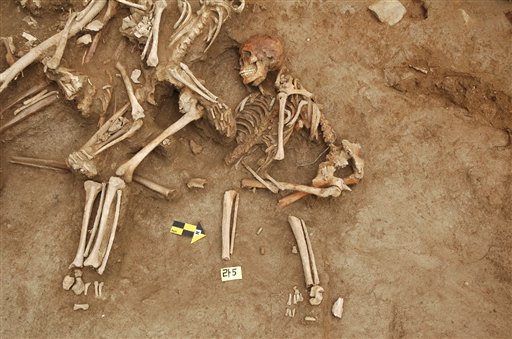
With US military officers sometimes present, and as North Korean invaders pushed down the peninsula, the southern army and police emptied South Korean prisons, lined up detainees and shot them in the head, dumping the bodies into hastily dug trenches. Others were thrown into abandoned mines or into the sea.
Women and children were among those killed, many of whom never faced charges or trial.
The mass executions — intended to keep possible southern leftists from reinforcing the northerners — were carried out over mere weeks and were largely hidden from history for half a century.
They were “the most tragic and brutal chapter of the Korean War,” said historian Kim Dong-choon, a member of a two-year-old government commission investigating the killings.
Hundreds of sets of remains have been uncovered so far, but researchers say they are only a tiny fraction of the deaths. The commission estimates at least 100,000 people were executed, in a South Korean population of 20 million.
That estimate is based on projections from local surveys and is “very conservative,” said Kim. The true toll may be twice that or more, he said.
In addition, thousands of South Koreans who allegedly collaborated with the communist occupation were slain by southern forces later in 1950, and the invaders staged their own executions of rightists.
Through the postwar decades of South Korean right-wing dictatorships, victims’ fearful families kept silent about that blood-soaked summer. American military reports of the South Korean slaughter were stamped “secret” and filed away in Washington. Communist accounts were dismissed as lies.
Only since the 1990s, and South Korea’s democratization, has the truth begun to seep out.
In 2002, a typhoon uncovered one mass grave. Another was found by a television news team that broke into a sealed mine.
Further corroboration comes from a trickle of declassified U.S. military documents, including U.S. Army photographs of a mass killing outside this central South Korean city.
Now Kim’s Truth and Reconciliation Commission has added government authority to the work of scattered researchers, family members and journalists trying to peel away the long-running cover-up.
The commissioners have the help of a handful of remorseful old men.
“Even now, I feel guilty that I pulled the trigger,” said Lee Joon-young, 83, one of the executioners in a secluded valley near Daejeon in early July 1950.
The retired prison guard said he knew that many of those shot and buried en masse were ordinary convicts or illiterate peasants wrongly ensnared in roundups of supposed communist sympathizers. They didn’t deserve to die, he said. They “knew nothing about communism.”
The 17 investigators of the commission’s subcommittee on “mass civilian sacrifice,” led by Kim, have also been dealing with 215 cases in which the U.S. military is accused of the indiscriminate killing of South Korean civilians in 1950-51, usually in air attacks.
The commission last year excavated sites at four of an estimated 150 mass graves around the country, recovering remains of more than 400 people. It has officially confirmed two large-scale executions.
In January, then-President Roh Moo-hyun, under whose liberal leadership the commission was established, formally apologized for the more than 870 deaths confirmed at Ulsan, calling them “illegal acts the then-state authority committed.”
Photos taken by an American Army major and kept classified for half a century show the macabre sequence of events.
White-clad detainees — bent, submissive, with hands bound — were thrown down prone, jammed side by side, on the edge of a long trench. South Korean military and national policemen then stepped up behind, pointed their rifles at the backs of their heads and fired. The bodies were tipped into the trench.
Scattered reports of the killings did emerge in 1950 — and some did not.
British journalist James Cameron wrote about mass prisoner shootings in the South Korean port city of Busan — then spelled Pusan — for London’s Picture Post magazine in the fall of 1950, but publisher Edward Hulton ordered the story removed at the last minute.
In 1953, after the war ended in stalemate, after the deaths of at least 2 million people, half or more of them civilians, a US Army war crimes report attributed all summary executions here in Daejeon to the “murderous barbarism” of North Koreans.
Such myths survived a half-century, in part because those who knew the truth were cowed into silence.
The immediate concern of the Truth and Reconciliation Commission is resources. “The current government isn’t friendly toward us, and so we’re concerned that the budget may be cut next year,” commission president Ahn Byung-ook said.
South Korean conservatives complain the “truth” campaign will only reopen old wounds from a time when, even at the village level, leftists and rightists carried out bloody reprisals against each other.
The life of the commission — with a staff of 240 and annual budget of $19 million (€12.3 million) — is guaranteed by law until at least 2010, when it will issue a final, comprehensive report.
Later this spring and summer its teams will resume digging at mass grave sites.
By exposing the truth of such episodes, “we hope to heal the trauma and pain of the bereaved families,” the commission says.
It also wants to educate people, “not just in Korea, but throughout the international community,” to the reality of that long-ago conflict, to “prevent such a tragic war from reoccurring in the future.”
Monday 1 July 2013
http://may131969.wordpress.com/2013/07/01/death-squads-and-mass-graves-the-full-horror-of-the-korean-war-finally-unearthed/

0 comments:
Post a Comment